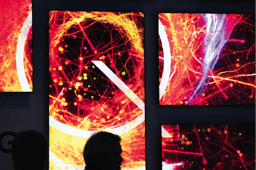The Modern Workplace Is Evolving and InfoComm Revealed What's Next

What once felt impressive — polished video, fast startup times, flexible room setups — now feels like the bare minimum. For organizations designing modern workplace environments that support collaboration, communication, and experience, two imperatives have emerged:
- Quality
- Speed
While AI is certainly a driving force, quality and speed are being shaped and accelerated by ever-changing user expectations. We sat down after InfoComm with a few of FORTÉ’s innovation team leaders to take a closer look.
Quality Is the New Baseline
Users aren’t just looking for tools that function. Today, they expect experiences that feel polished, professional, and seamless.
“It’s not good enough that you had your meeting and could be heard,” said Jason Moulden, Managing Director of the Microsoft Solutions Business at FORTÉ. “People expect more. They want to come across clearly, confidently, and credibly.”
Whether it’s intelligent auto-framing cameras, beamforming microphones, or simply having the right lighting and layout, quality has become a core part of how users judge effectiveness. What used to be a nice-to-have is now the standard.
“They’ve seen what good looks like, and they want to get there,” added Keith Yandell, FORTÉ’s SVP of Innovation. “Even if they’re starting from a home office setup.”
This is especially true for executive broadcasts and all-hands meetings, where credibility and polish matter more than ever. Yandell noted a range of InfoComm solutions aimed at helping companies broadcast with ease and consistency.
KEY TAKEAWAY: Quality isn’t just about hardware; it’s also about how people experience the space. If you're designing or upgrading AV environments, evaluate the full journey: how easy it is to get started, how confident users feel during meetings, and how consistently it works across rooms.
Speed Is the New Differentiator
If quality is the new baseline, speed is the multiplier. At InfoComm, the most interesting solutions weren’t just smart, they were fast.
“You can say, ‘Put me in a library,’ and the system instantly generates a background image that surrounds you with books,” said Yandell. “The old workflow would have taken much longer, and many times the user simply gave up and used an unrelated image.”
This wasn’t just a party trick. It was a reflection of where users are drawing the line: if it slows them down, they’re not interested.
Moulden points out that users don’t want to configure a solution, they just want to use it. Plug-and-play room systems with familiar interfaces, BYOD-friendly setups, and edge-based digital signage powered by NPUs all reflect this shift.
From setup to connection to deployment, speed now shapes every expectation.
KEY TAKEAWAY: If you're evaluating platforms or tools, look closely at how much effort they require from your teams. Friction slows adoption.
How Rising Expectations Are Changing Workplace AV Strategy
Rising expectations aren’t just reshaping solutions, they’re also reshaping strategies.
Today’s spaces are expected to do more, flex faster, and support a broader range of experiences than ever before. Whether it’s a hybrid meeting room, an all-hands space, or an impromptu collaboration zone, quality and speed are now baked into the baseline expectations.
“Workplace technology can’t be static, not when user expectations constantly shift,” said Jason Roberts, VP of Workplace Strategy at FORTÉ. “We’re designing ecosystems that don’t just meet today’s needs, but are built to flex with tomorrow’s demands. It’s about creating spaces and systems that are intuitive now and adaptable next so they stay relevant as workstyles evolve.”
And it’s not just the environments that need to keep up, it’s also the tools inside them. One example from the show floor? Microsoft-certified boards. These all-in-one solutions are designed to meet Microsoft’s evolving standards right out of the box. This is a clear response to users expecting systems that are familiar, fast, and frictionless from the first tap.
And while no single piece of tech stole the show this year, all three leaders we talked with pointed to the value of incremental change. From auto-framing video bars to touchless room controls, modern workplace tools are evolving in steady, meaningful ways.
Key takeaway: If you're responsible for workplace planning, remember that users want technology that feels as intuitive and seamless as what they use at home. Staying ahead of their expectations means making ease of use a core design principle—not a nice-to-have.
Modern Workplace Solutions: What to Do Now
InfoComm 2025 wasn’t about revolutionary tech, it was about a new baseline. And the organizations that meet expectations for speed and quality won’t just keep up—they’ll lead.
Here are a few starting points to consider:
- Audit your current spaces against today’s expectations: Are they fast? Intuitive? Confidently professional?
- Look for ways to reduce friction: If users are fumbling with cables, settings, or interfaces, it’s time to rethink.
- Plan for speed and change: Choose systems and partners that can adapt fast without requiring a full reset every 18 months.
Your users are already expecting more. Let’s make sure your communication and collaboration strategy delivers it.






Please sign in or register for FREE
If you are a registered user on AVIXA Xchange, please sign in
Great to see quality finally becoming a bigger part of the conversation.
The pandemic pushed us into remote work overnight, and for a while, we made do with whatever technology could simply keep us connected. The bar for quality was incredibly low. Now, expectations have shifted—we want systems that work reliably, sound great, and respond quickly. That’s good news for integrators, especially those who design with acoustics and lighting in mind.
I’ve spent my career advocating for the integration of systems and spaces. Before moving into AV integration, I ran a company focused on room and audio acoustics, often supporting commercial integrators as a specialist. I can’t help but hear the problems when audio is poorly implemented—it still happens far too often.
Fortunately, awareness is growing. As more people work remotely and experience the far-end perspective, they're starting to recognize the true value of thoughtful system design. It’s one thing to use the system in the room—it’s often another to experience how it sounds and looks from the other side.